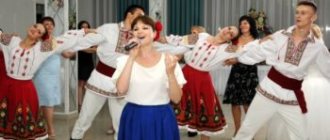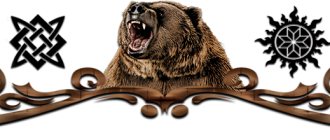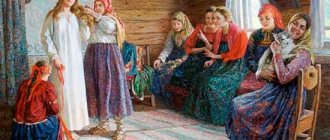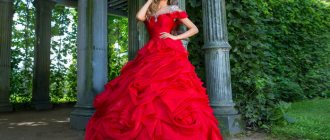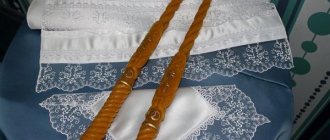How does matchmaking and engagement work?
Previously, among Ossetians, unmarried girls led a reclusive lifestyle, which excluded any doubt about their moral qualities - most often, guys could freely communicate with girls only at a special celebration (khazt).
Only people who were not related by marriage gathered at the gatherings, which made it possible to choose a mate. A man came to such an event only if he felt the need to start a family. He had to be sure that he was ready to take on the responsibility of providing for his wife and children. At the same time, it is important that the guy has a good income and a place where he can bring his wife.
The guy could attend several holidays, looking closely at the girls. When one of them seemed attractive to him, he informed his relatives about it. They collected information about the girl, finding out how she met the requirements that a good wife should meet:
- modesty;
- the ability to create high-quality handicrafts;
- a good, sensible housewife.
And only after that could we talk about beauty. If the girl did not have the special inclinations that are required for a wife, then even the most attractive appearance could not help her get married successfully. After all, it was important for the family that its new member had equal rights and did not parasitize on other people. The development of hard work and restraint in regard to beauty was also facilitated by the fact that representatives of the upper class of Ossetians (Aldars) preferred to marry each other. If this was impossible, then they looked for a wife among the princesses of other tribes.
The Ossetians observe one useful law, which prohibits consanguineous marriages.
This definition includes all namesakes and those who trace their descent from the same ancestor. This is observed on the paternal and maternal lines. It was also not recommended for people whose grandmothers were from the same family to marry.
If the relatives approve of the man’s choice, they begin matchmaking. To do this, they invite friends or relatives who have achieved respect among the people. The matchmakers visit the girl's house three times, and only after that they receive an answer. Moreover, each time the head of the family, receiving a delegation, is polite and courteous, making it clear that he is not against his daughter’s wedding.
But at the same time, the man avoids a direct answer until the end of the third meeting. This tradition is observed even if the father planned to refuse from the very beginning. One of the first and most important issues discussed at these meetings is the size of the bride price. Depending on whether the matchmakers agree with the appointed amount and how quickly the groom can collect it, the frequency of visits to the bride’s house depends.
At the last meeting, the head of the family voices the final decision, after which the wedding date is set. The decision is considered final only after the deposit is transferred to the girl’s family. If this is not done within the agreed time frame, then the relatives may consider the guy not serious.
This will cause a break in the agreement - the man broke his word. When all the funds have been transferred, the bride is declared matched.
Shoes
Kazakh national shoes reflect the nomadic life of this people. Due to the need to constantly change places, high boots predominate. The wide tops are convenient for tucking in pants for greater warmth retention.
- Boots for the summer could have heels. In the old days, socks were sewn turned up. Young girls wore shoes with decorations in the form of appliqués and embroideries.
- A heel of about 8 cm was popular among young men. For convenience, older people wore soft boots without heels. Over them were put on galoshes or leather shoes.
- Poor people, shepherds wore boots made of felt with leather soles. The poor were forced to wear sandal-like shoes, which consisted of leather soles that were attached to the feet with straps.
Wedding preparations
When a girl is preparing for a wedding, she has a number of restrictions. It is believed that at this time she should not have fun - she needs to prepare for family life. Therefore, she does not attend entertainment events and organizations, even when accompanied by friends or relatives.
She devotes all her time to helping elders organize the holiday. The second significant restriction is that the girl should not see the groom’s relatives. The last stage is the secret meeting of the bride and groom. The man must, accompanied by friends, come to the bride without being caught.
When he succeeds, he gives his beloved a ring, after which the engagement is considered concluded. In order to meet the girl without causing the anger of her parents and without casting a shadow on her honor, they came up with an interesting way. The groom, along with the witness and the bride's friends, come to her house in the evening. The man must present all the women at home with sweet treats, after which they organize a festive table, on which there must be three pies for the young people.
After this, folk music begins to play in the courtyard, and guests and hosts come out to dance.
There is one peculiarity at the banquet - the mother of the bride must serve a glass of wine to her future son-in-law. And other women of the clan bring dishes to the rest of the guests, not forgetting the groom’s friends with whom he came.
Before drinking the treat, the guys must make a solemn toast. And according to tradition, you need to put money in empty dishes. This demonstrates the man's generosity and wealth. The entire banquet is held so that the man has the opportunity to meet the bride. He must find a moment when they are not being watched and give her an engagement ring.
It is important to do this discreetly, so that later the relatives can be “surprised” that their daughter is suddenly engaged. After the appearance of the ring is discovered, the celebration gains momentum. Almost everyone goes dancing, some start singing or playing musical instruments. The festivities can continue until late at night, but it is important that the groom and his entourage do not stay overnight.
Before marriage, a man and woman should not spend the night under the same roof, even in different rooms.
Wedding dresses
Ossetian wedding clothes fully correspond to the legendary epic. Grooms rarely wear the Ossetian national costume anymore, but brides do not change traditions. Her outfit symbolizes the body of a dove, in which the divine princess once appeared. It consists of mandatory elements: long sleeves that symbolize the age of marriage, bibs, patterns on the hem of the dress and on the sleeves, and a metal belt. The dress itself should be floor-length and completely covered. The bride's outfit is also complemented by a round cap and veil.
Wedding dresses in Ossetia always have a luxurious and expensive appearance. They are richly and skillfully decorated. The bibs on the bride's dress symbolize the branches of the Tree of Life. A metal belt at the waist protects against evil forces, and the patterns are a strong talisman.
The pattern on an Ossetian wedding dress can be serpentine or floral. They are considered very ancient and highly revered. Ornaments symbolize nature in its various manifestations. They are located along the edges of the dress, where its protective function ends. The cap is also decorated with similar patterns.
At an Ossetian wedding, everything has a fabulous and solemn look. Here you can see many ancient rituals that delight you with their originality.
Celebration
The wedding celebration begins by inviting in advance the respected people who will be in the cortege.
The most venerable one is declared the head of the train, who will take on most of the speeches, as well as solving problems. These men gather a few days before the start of the holiday and discuss all the nuances of the celebration, and also share responsibilities among themselves.
The wedding cortege begins its journey from the groom's house, trying to inform others as much as possible about the reason for their trip. When they reach the bride's house, they are met there by family elders and honorable guests, who present special treats to the visitors:
- three pies;
- beer;
- araka (alcoholic drink made from grain);
- national snacks.
At the moment of donation, praise is offered to God and a prayer is made that this house will always be welcome to visit such esteemed guests. When the leader of the cortege accepts the gifts, he expresses gratitude for the greeting. After this, the man blesses the families who are going to become related.
The rest of the men who arrived should do the same. After all the gifts have been handed over, the guests are brought into the house, where a laid table with treats awaits. It is desirable that there are many different dishes present. This will show that guests are welcome, and good housewives live in the house. When everyone is seated, songs and toasts begin, while the mother of the bride tries to make the eldest of the train feel comfortable.
It is important to remember that if there is a family in mourning near the bride’s house, then the girl’s father must send them a letter a few weeks in advance.
It says that a celebration is planned, but he respects the grief of others and does not know what to do correctly. After that, they send him a response in the same way with permission to celebrate, because they respect other people’s happiness.
When some time has passed, the head of the train asks for three ribs of a sacrificial ram. After they are brought to him, he divides them and hands them along with the glasses to the women of the clan. At this time, three toasts are made:
- Praising the women and girls who prepared the festive treat.
- To all guests.
- The eldest woman in the bride's family.
At this time, some of the women help the bride to dress up, and when she is ready, it is announced. After this, the elder must pay the agreed ransom, and only after that the girl will be shown to them. At the same time, it is desirable that during the bargaining process emergency situations occur that will amuse everyone present.
After the bride is handed over to the newcomers, they go to the groom's house.
When the motorcade enters the courtyard, the car is surrounded by young people who sing funny songs and joke. The bride is brought to 3 older men who read a prayer to God in gratitude for the joyful event. After this, the bride is helped to carry out the process of removing the veil and taken to the house where the 3 oldest women are sitting.
Before she crosses the threshold, she is given a little boy to hold, so that the first child will be male.
After this, she must step over the threshold, and it is important that she enters the house with her right foot without tripping.
When the girl is under the roof, she immediately bows deeply to each elder, showing respect. In response, she hears prayers to God, in which they thanked him for such a well-mannered girl. Next, the bride is escorted to a designated room and dancing is arranged. After a certain time, the train foreman comes for the bride and takes her out into the yard to remove the veil.
This is done by a young unmarried youth who is a close friend or relative of the groom.
He removes the veil using a special flag sent from the bride's home. At the same time, he wishes her fertility, many sons and one daughter. The flag used to remove the veil is solemnly hung in the house above the stove.
After the bride's veil is removed, she must present the elder women with a bowl of honey, which was sent from her parents' house.
At the same time, the elders want her to have the same sweet life in marriage. Next, the girl is escorted to a room where dancing and singing continue.
While the bride is being welcomed into the groom's house, the man comes with a witness to the bride's house. They are waiting for him there, because everyone is interested in how the new relative will turn out. A guy should show modesty and moderation in food and alcohol so as not to show himself in an unattractive light. It is after this banquet that his relatives and neighbors will determine their opinion towards him.
A man, having arrived at the house, must present the women with candies or other sweets. After this, in the midst of the celebration, he and two friends ask to get up from the table, looking at the women. There they are given 3 glasses, and they must make 3 toasts to the hostesses, and then fill the dishes with money. The men return to the table and continue to celebrate.
The fun often ends after midnight when the new relative leaves for the older train's house.
Peculiarities
Traditional Tatar wedding attire must be chaste, covering the entire body of the newlywed: neck, décolleté, arms, legs. Only the hands and face were allowed to be left open to the eyes of the guests.
Tatar costumes are characterized by bright colors, the presence of velvet and patterns, mostly gold. Main features and details of the national wedding dress:
- A floor-length skirt is the main and important element of the image. It is richly embroidered with gold threads, from which the most beautiful Tatar ornaments are “drawn”.
- Stand-up collar covering the décolleté area.
- Long, opaque sleeves – they can be flared or straight.
- Camisole (long or short), repeating the color tone of the dress.
- A fez is a headdress borrowed from the Turks at the beginning of the 20th century, or a kalfak is a national wedding cap.
- Colorful shoes: colored ballet shoes made of genuine leather or pointed-toed Tatar shoes, embroidered with golden patterns. Light openwork boots were also worn.
- Beautiful ringing coins, which the Tatars call solps. They became a mandatory addition to the image of the newlywed. In general, the abundance of expensive jewelry - large earrings, numerous bracelets and other jewelry - testified to the status of the bride in society and the wealth of her groom. Only all this “beauty” had to fit harmoniously into the overall image and festive attire.
At modern Tatar weddings, wedding dresses stylized from European manners are increasingly common, but the special flavor of the national costume is still preserved in them. The traditional headdress is worn less and less, instead they use a hijab, or simply a fluffy veil, emphasizing the beauty of the hairstyle. For footwear, brides prefer low-heeled shoes.
Bride image in oriental style
Many brides admire the beauty and uniqueness of oriental beauties, dreaming of feeling like they are in their shoes. That is why some newlyweds decide to have a wedding in an oriental style, borrowing part of the culture of Muslim countries. The wedding portal svadbagolik.ru is confident that you can easily choose a wedding dress in an oriental style to feel the atmosphere and get unique photos.
Tips for creating an oriental look:
If you are far from the Muslim faith, you do not have to follow all the rules of an eastern wedding
You can choose a dress with oriental motifs, but you don’t have to cover your arms and neck, or completely cover your head with a scarf, so that you don’t look too conservative in your wedding photos. Pay special attention to the selection of oriental-style accessories that will make your look more harmonious. These can be earrings, a voluminous necklace, which can be worn over a dress with a closed neck, as well as a belt made of stones and numerous bracelets. The final highlight of the image can be bright oriental makeup, which usually focuses on the eyes, because they are the mirror of the soul: through them the bride demonstrates love and respect for her other half.
Varieties
The traditional men's suit consists of a simple black frock coat and cape.
The distinctive feature of this cape is that, although it looks like outerwear, it is worn not only over, but also under a shirt. The main thing is that the brushes are located on top of the trousers.
Women's national costume consists of a dress or blouse with a skirt and an apron. The apron performed not only the function of protection from household dirt, but also protected from the evil eye.
The dresses of women of the old faith were long and decorated with hand embroidery or lace. The arms were hidden behind long sleeves that tapered at the wrists. This dress also had a stand-up collar, decorated with lace and tightly clasping the neck. A leather belt also wrapped around the waist with a tight ring.
A children's costume for girls was practically no different from an adult outfit. The dress was also quite closed, but shorter. Boys under the age of thirteen did not wear the “citit” cape. It was allowed to be worn only by those who had reached the age of majority by celebrating their barmitzvah. It was after this event that the boy was considered a man.
Kazakh weddings take place on a large scale - a rich table, toastmaster, dancers, showmen
A Turkish wedding costs a little more than ours, since the price for renting a restaurant, cars and other things is much higher than in Kazakhstan.
One of the distinctive features of a Turkish wedding is “kina gecesi”, where only females are invited.
Also unusual is that the bride’s palms are painted with henna. Everyone sings songs and dances Turkish traditional dances, and there are sweets and soft drinks on the table.
On the day of marriage registration, I put on a simple wedding dress, we went to the registry office and held a wedding ceremony with loved ones.
In the evening, my husband and I went to a restaurant, where we spent a magical and relaxing evening.
About plans
We are planning to buy a house on the Aegean coast, where we plan to relax with family and friends.
Embroidery and patterns in traditional Russian dress
It is difficult to imagine a Slavic wedding costume without characteristic patterns and embroidery.
Embroidery can have a floral focus: red poppies, daisies, chrysanthemums, tulips, sunflowers, silhouettes of flower buds add elegance and lightness to the image. Images of rowan bunches look very beautiful on wedding dresses.
Animal motifs on wedding dresses are presented in the form of bird silhouettes.
Gzhel and Khokhloma are often used by designers when creating modern clothing. Traditional Slavic patterns have not been spared from wedding dresses. The ornament in this style can be located on the chest, skirt or the entire length of the dress.
Russian motifs also appear in geometric and abstract patterns: diamonds, smooth lines, curls, hand-embroidered with red, blue, yellow or shiny threads, can help curvy girls hide figure flaws. It is especially beneficial if the contrasting pattern is located vertically on the sides, which allows you to elongate the silhouette and get a slimmer figure.
Models of dresses with patterns at the bottom of the skirt are suitable for tall girls.
Gimp decorates most models of wedding dresses in the traditional Russian style, as does colored braid.
Pearls, furs and openwork patterns will look great on girls with any type of appearance and any figure. They make the image even richer, emphasize the stateliness of the bride and complete a stylish ethnic outfit.
Painted details of clothing and accessories enhance the overall perception of the image, especially if they are made in red. Embroidery in ancient motifs will decorate any girl, and in combination with a chic dress and blush on the cheeks will help the bride become a newlywed lady or a merchant's daughter.
Story
Previously, according to the peculiarities of the Tatar wedding, it was customary for the parents to present the future bride with fabric for sewing a wedding attire. Or the girl chose the piece of linen she liked from the groom’s wedding gifts, presented a week before the celebration.
The Koran teaches to have only the most necessary things, avoiding excesses, so festive clothes became those that were worn later in everyday life. It could be:
- tunic (sometimes complete with pants);
- loose fit dress;
- traditional national costume, suitable for any occasion - shirt, bib and trousers.
A little later, camisoles and beshmets came into fashion. This is outerwear: a camisole is a fitted short vest, a beshmet is a long coat tapered at the back. It was customary to decorate them with fur, gold embroidery, and silver clasps that replaced standard buttons. The color scheme of festive dresses did not differ in variety; Tatar wedding dresses could be of three colors:
- emerald;
- burgundy;
- bright blue.
In modern Tatarstan, the bride has the right to independently choose the color and style of her wedding dress, as well as the fabric for it.


